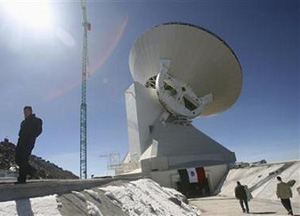 |
 |
 |
 News Around the Republic of Mexico | November 2006 News Around the Republic of Mexico | November 2006  
Scientists Flick Switch on Giant Telescope
 Reuters Reuters


| | The world's largest milimetric telescope is seen near the summit of the Sierra Negra volcano over 4500m above sea level November 22, 2006. (Imelda Medina/Reuters) |
Scientists turned on a massive telescope built on one of Mexico's tallest mountains on Wednesday, hoping to get a glimpse of the beginning of the universe.

With a base like a launching pad and an antenna the size of a big Ferris wheel, the Large Millimeter Telescope or LMT, will be used to pick up electromagnetic radiation known as millimeter waves emitted 13 billion years ago, when the first stars burst into existence, astrophysicists say.

"This telescope ... will allow us to make fundamental discoveries about the formation and evolution of galaxies, about the formation and evolution of stars, and about the origin of the universe itself," National Astrophysics Institute Director Jose Guichard said during the inauguration.

The $128 million telescope is a U.S.-Mexican project built on the 15,026-foot (4,580-metre) summit of Sierra Negra, Mexico's fifth-highest peak, in air so thin that bottled oxygen is kept at hand in case workers faint.

With an antenna diameter of 164 feet, the LMT dwarfs existing millimeter-wave telescopes and should be able to pick up signals from the faintest objects in outer space.

While optical telescopes detect light rays and others look for radio, infrared or gamma waves, the LMT picks up electromagnetic radiation at wavelengths of 1 to 3 millimeters -- shorter than radio waves but longer than infrared, visible light and gamma rays.

Sierra Negra, an extinct volcano to the east of the city of Puebla in central Mexico, was chosen because of its height and mild climate. While oblivious to light pollution, millimeter telescopes work best at altitudes where the level of water vapor in the air is low. | 
 | |
 |



